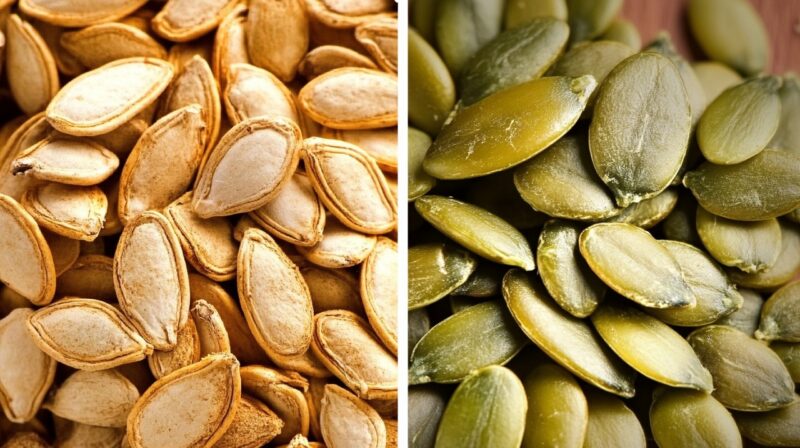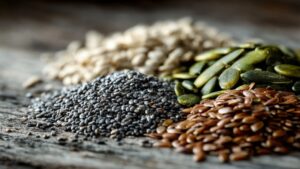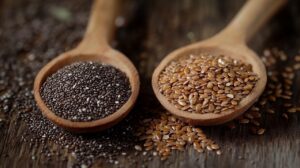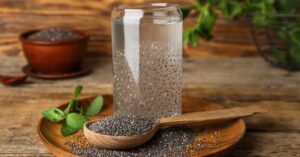Pepitas and pumpkin seeds often confuse many people who want to add nutritious snacks to their diets. Both come from pumpkins, but important differences set them apart. Many people see them as interchangeable, yet their textures, flavors, and uses offer distinct experiences. Choosing between them depends on the intended purpose and the type of nutritional boost one seeks.
Pepitas appear without a shell, displaying a smooth green surface that many appreciate for its tender texture. Pumpkin seeds, on the other hand, usually come with a white, fibrous shell that adds extra crunch and fiber. Understanding their differences helps when selecting the best option for snacking, baking, or health supplementation.
Both deliver impressive health benefits, including heart support, better sleep quality, and strong immune function. Exploring their features, nutritional values, and culinary applications brings clarity to anyone seeking the best snackable superfood.
Appearance and Origin
| Feature | Pepitas | Pumpkin Seeds |
|---|---|---|
| Source | Styrian or oilseed pumpkins | Common carving pumpkins |
| Shell Presence | No shell | Has a hard white shell |
| Appearance | Small, green, smooth | Larger, white, fibrous outer layer |
| Texture | Tender and soft | Crunchy and firm |
| Flavor | Mild and buttery | Earthy and slightly bitter |
| Common Usage | Raw snacking, baking, garnishes | Roasting with seasoning |
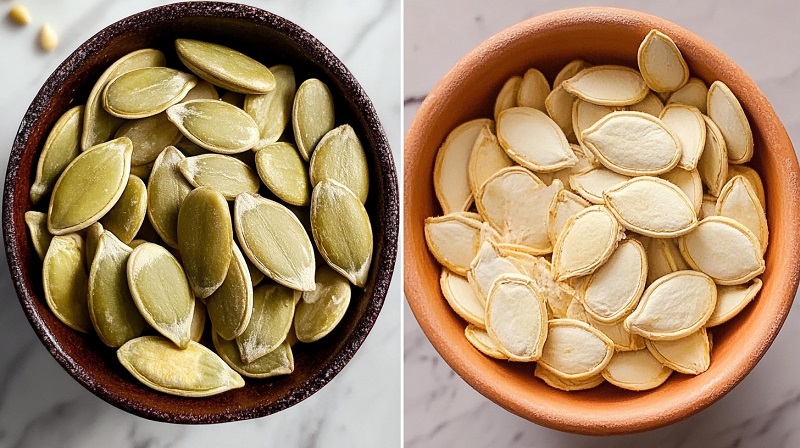
They both come from pumpkins but develop in different ways. Pepitas grow inside special varieties of pumpkins known as oilseed or Styrian pumpkins. These pumpkins naturally produce seeds without a hard outer shell. Pepitas appear flat, green, and smooth, offering a tender and mild flavor ideal for raw snacking or baking.
Pumpkin seeds, in contrast, grow inside the more common field pumpkins often used for carving or decoration. These seeds develop with a tough, fibrous white shell surrounding the green inner kernel. Roasting pumpkin seeds with the shell creates a crunchy snack that carries a slightly earthier flavor than pepitas.
Shape and size also show visible differences. Pepitas usually look smaller and more uniform in appearance. Pumpkin seeds, because of their shell, appear larger and bulkier. Texture plays a major role too, with pepitas offering a softer bite compared to the harder crunch of pumpkin seeds.
Nutritional Value
Pepitas and pumpkin seeds both offer impressive nutritional profiles. Both serve as powerful sources of plant-based protein, healthy fats, and essential minerals. Even though they share many similarities, slight differences exist depending on the form in which they are consumed.
Pepitas, without the outer shell, provide direct access to all nutrients without the additional fiber that comes from the hard shell of pumpkin seeds. Pumpkin seeds, eaten with the shell, offer higher fiber content, making them a good choice for digestive health support. However, the presence of the shell slightly reduces the concentration of other nutrients by weight.
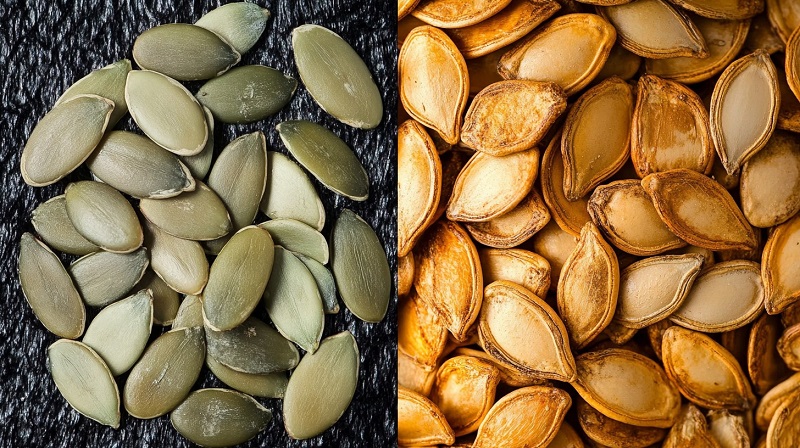
Both options contribute important amounts of magnesium, iron, zinc, potassium, and antioxidants that help support overall health. Including either option in daily meals can enrich dietary patterns with critical micronutrients.
| Nutrient | Pepitas (No Shell) | Pumpkin Seeds (With Shell) |
|---|---|---|
| Calories | 559 kcal | About 450 kcal |
| Protein | 30 g | About 20 g |
| Total Fat | 49 g | About 35 g |
| Fiber | 6 g | About 18 g |
| Magnesium | 592 mg | About 450 mg |
| Iron | 8.8 mg | About 6 mg |
| Potassium | 809 mg | About 650 mg |
| Zinc | 7.8 mg | About 6 mg |
Health Benefits
They both support health in multiple ways. Each seed holds compounds that benefit the heart, immune system, digestion, mood, and hormone balance. When eaten regularly, they help improve nutritional quality and strengthen wellness. Choosing between them depends on texture preference, shell tolerance, and desired dietary goals.
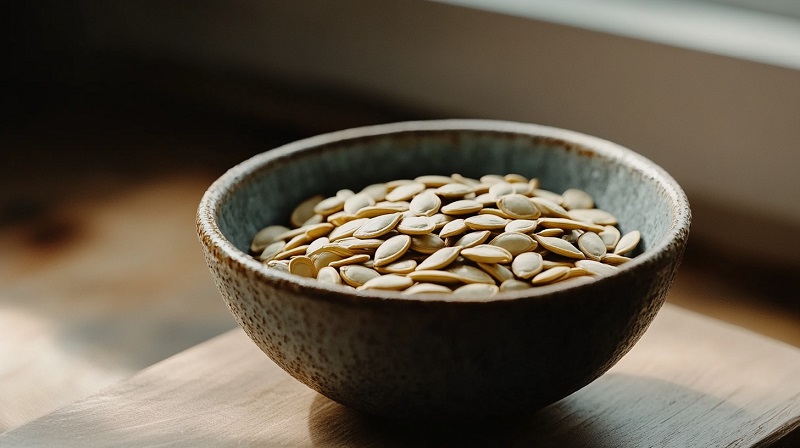
Cardiovascular Support
Both provide high amounts of magnesium and healthy fats. Magnesium helps regulate blood pressure and supports steady heart rhythm. The combination of unsaturated fats and antioxidants lowers harmful cholesterol and improves blood vessel function.
Pumpkin seeds also offer phytosterols. These plant-based compounds block cholesterol absorption, further protecting the heart. Pepitas, with their concentrated nutrient content, deliver these benefits more efficiently.
Better Sleep Quality
Tryptophan, found in both seeds, supports better sleep cycles. This amino acid helps produce serotonin, which converts to melatonin. Eating a small amount of seeds before bed may help regulate rest patterns, especially when paired with healthy carbohydrates.
Zinc and magnesium also help in sleep regulation. Pepitas, due to their lack of shell, allow for better absorption of these minerals in smaller servings.
Hormonal and Prostate Health
Pumpkin seeds support prostate health by helping reduce symptoms of benign prostatic hyperplasia. Their zinc content helps regulate hormone levels, supports testosterone balance, and strengthens reproductive health in men.
Pepitas offer similar support. Their rich oil content carries phytoestrogens that may benefit hormone balance for both men and women.
Immune and Anti-Inflammatory Effects
Both seeds contain antioxidants like vitamin E, zinc, and carotenoids. These compounds reduce inflammation, protect immune cells, and support faster recovery during stress or illness. Zinc plays a key role in defending the body against pathogens, especially during seasonal infections.
Consuming a handful daily can offer long-term protection, especially when paired with fruits and vegetables.
How to Use Them in the Kitchen
Pepitas and pumpkin seeds both deserve a spot in the kitchen, but each one brings its own texture, flavor, and cooking style. Choosing one depends on how crunchy or smooth the recipe should feel, and how the seed will interact with other ingredients.
Pepitas have a mild, nutty flavor and a soft bite. They do not have a shell, so they blend easily into foods. You can toss them on top of salads, bake them into muffins, or stir them into yogurt. When toasted, they release a deep aroma and become slightly crisp without turning hard.
Pumpkin seeds with the shell bring a whole different experience. Their outer layer gives a satisfying crunch, especially when roasted with sea salt or spices. Many people eat them like popcorn or sunflower seeds, enjoying the rough texture and earthy flavor.
What Works Best
Pepitas fit well with
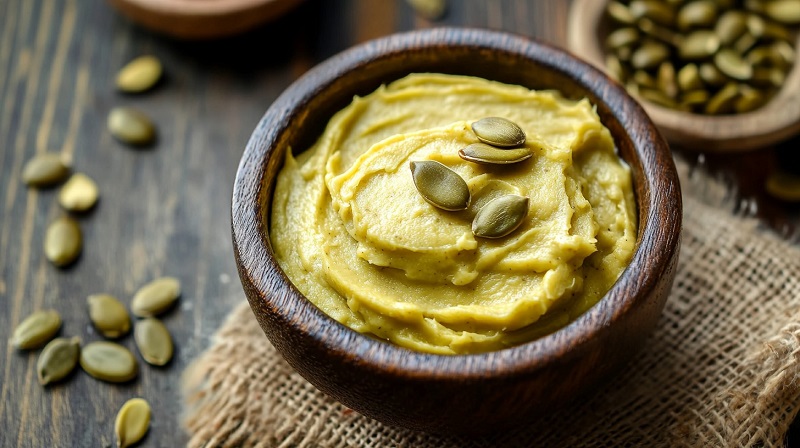
- Smoothies and protein bowls
- Granola, trail mix, and baked bars
- Homemade seed butter or pesto
- Fresh salads, tacos, or wraps
Pumpkin seeds work great in
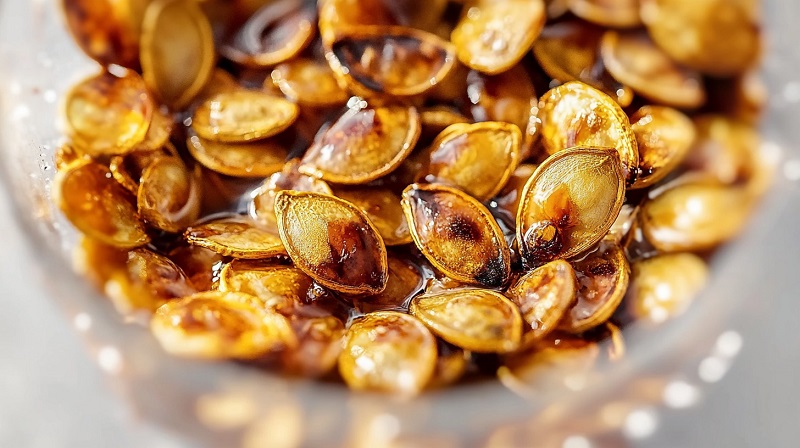
- Roasted snack bowls with chili or garlic
- Crunchy toppings on soup or stew
- Breading for chicken or roasted veggies
- Spiced blends with cinnamon or cumin
Storage Tips
Both seeds keep well in sealed jars or containers. They stay fresh longer when stored away from light and heat. Raw pepitas last several months in the pantry. Roasted pumpkin seeds benefit from refrigeration to preserve oils and crisp texture.
What to Know Before You Buy
Choosing quality pepitas or pumpkin seeds means looking past the packaging and thinking about freshness, origin, and how the seeds were processed. Not every seed on the shelf gives the same value or taste, and some options offer better nutrition or shelf life than others.
Look for Freshness First
Fresh seeds should smell clean and slightly nutty. A sour or stale smell signals oxidation or poor storage. Always check the expiration date, especially with roasted seeds. Oils inside the seed can go rancid when exposed to heat or light for too long.
Raw seeds tend to last longer, especially pepitas without added oil or salt. If buying in bulk, choose stores that keep seeds in cool containers and away from direct sunlight.
Read the Label
Details on the package can tell a lot. Look for:
- “Raw” or “dry roasted” if you want low-sodium or unsweetened options
- “Hulled” if you want pepitas or seeds without shells
- “Organic” to avoid pesticides or chemical treatments
- “Unflavored” if planning to season them at home
Common Myths About Pepitas and Pumpkin Seeds
People often treat pepitas and pumpkin seeds as the same thing, or assume certain facts without checking the details. Many of those ideas come from packaging confusion or assumptions based on appearance. Clearing up the most common myths helps avoid mistakes in buying, cooking, or nutrition tracking.
Myth 1: Pepitas Are Just Shelled Pumpkin Seeds
Fact: Pepitas come from a specific type of pumpkin that naturally grows shell-free seeds. They are not regular pumpkin seeds with the shell removed. Their texture and flavor also differ because they develop differently from the start.
Myth 2: Pumpkin Seeds Always Have a Shell
Fact: Regular pumpkins produce seeds with a shell, but once that shell is removed, the inside looks nearly identical to pepitas. However, those shelled seeds still came from a different variety of pumpkin.
Myth 3: Both Taste Exactly the Same
Fact: Pepitas have a mild, nutty flavor. Pumpkin seeds with shells taste earthier and sometimes bitter. Roasting methods, oils, and seasonings change both, but their natural flavors are not identical.
Myth 4: Roasting Destroys Their Nutrients
Fact: Light roasting keeps most of the minerals and fats intact. Extreme heat or added sugars and oils reduce health value, but dry roasting at home in a controlled way does not ruin their benefits.
Final Thoughts
Pepitas and pumpkin seeds both belong in a balanced, nutrient-rich diet. Each one brings its own set of strengths. Pepitas offer soft texture, quick digestion, and concentrated nutrients. They work well in blended dishes, baked goods, or meals that call for a smooth finish. Pumpkin seeds with the shell deliver crunch, high fiber, and bold flavor. They fit better in snack mixes, roasted toppings, and slow-chew eating habits.
Choosing between them depends on the moment. For fast prep and easy blending, go with pepitas. For hands-on snacking or high-fiber needs, use whole pumpkin seeds. Both options support heart health, better sleep, strong immunity, and stable energy levels.

